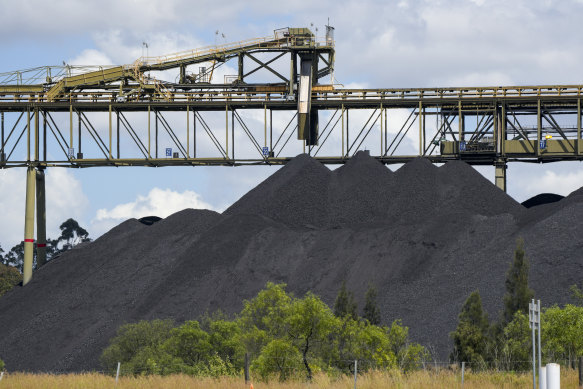
Fugitive emissions are greenhouse gases such as methane and carbon dioxide that leak into the atmosphere during both open-cut and underground mining operations. The other emissions referred to by the EPA are from HVO’s direct operations, such mining trucks and other machinery. As the coal is for export, the downstream emissions from burning the fossil fuels count in the importing countries, rather than locally.
HVO is a joint venture between Yancoal and Glencore located between Singleton and Muswellbrook. The company says coal has been mined on site for more than 70 years, and the operation employs 1300-1500 ongoing workers and 600 in temporary jobs.

Many analysts say that coal mining is in terminal decline.Credit: AP
The Department of Regional NSW has recommended the project go ahead because of its economic benefits. HVO’s updated modelling by consulting firm EY suggests the project will deliver $7.8 billion in economic benefit over its lifetime and $3.3 billion in royalties to the NSW government in today’s dollars.
Hunter Valley Operations general manager Dave Foster noted the EPA letter did not oppose the proposal, and the company had already committed to some of the consent conditions suggested by the agency, such as committing to review new mitigation technology before any of the deeper coal reserves are mined.
However, Foster said the company had “several concerns” about the letter’s contents.
“We believe its assessment of our mine’s share of NSW greenhouse gas emissions is misleading where they have been derived on a gross or total emissions basis,” Foster said. “It also appears the EPA intends to ring-fence carbon offsets to NSW, which contradicts the approach being adopted by the Albanese government under the safeguard mechanism.”
Loading
Foster said the proposal was to continue mining in currently approved areas with little additional disturbance, and no increase to current annual production volumes.
The coal would be exported via a rail link to the Port of Newcastle, which is the largest coal port in the world, but also a business actively preparing for a post-coal future to compete as a container terminal. Port of Newcastle chief executive Craig Carmody recently told The Sydney Morning Herald that key export customers such as Japan, Korea and China were rapidly phasing out coal and the market could die within a decade.
Yet, Foster said the proposal was “an effective way to meet continued demand from some of Australia’s key security and trading partners for our high-quality coal”. He said the International Energy Agency World Energy Outlook for 2023 forecasts that global demand for coal will continue to 2050 driven by demand in emerging markets in Asia.
The World Energy Outlook forecasts a 97 per cent decline from 2022 levels in the use of coal for energy globally in a net-zero scenario for 2050. The report also describes less ambitious scenarios, and the global decline in coal usage would be just 41 per cent based on current policy settings.
If HVO is essentially one of the last mines in operation this would be one reason why, as the EPA claims, it would represent 35 per cent of all NSW coal sector greenhouse gas emissions in 2045. However, the EPA also said it would contribute more than 3.5 per cent of the state’s total emissions in 2045, reduced to 0.5 per cent if the offsets occur in NSW.
Last month the first major government audit of Australia’s environmental offsets system found it was riddled with breaches, and dozens of major development projects could have broken the law.
The Department of Planning is waiting for the company’s response to the EPA, and will then prepare its report for the Independent Planning Commission.
Nic Clyde, NSW co-ordinator for anti-fossil fuels group Lock the Gate, said: “This decision is a huge test for the NSW government and its new climate change law – it’s time for clear direction in the planning system that monster polluters like the HVO expansion will not receive approval.”
Loading
The HVO expansion is one of 18 coal mining projects in the NSW planning system that are not yet approved. HVO started its application process in 2017, and it is now only a year before the first mine is due to close.
Proponents of renewable projects have also been encountering extraordinary delays in obtaining planning permission, with approvals taking two or three times longer than other states.
The EPA recently updated its rules to require an environmental impact statement for a large-emitting project to provide detailed and consistent information about greenhouse gas emissions, and plans to reduce, mitigate and offset them. The newest coal proposal in the planning system, a modification plan from Idemitsu for its Boggabri mine near Narrabri, will come under these new rules.









 Add Category
Add Category